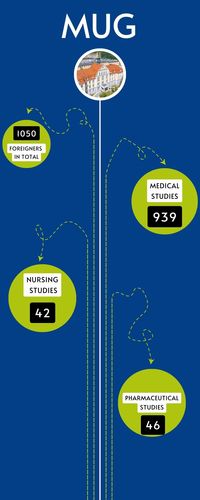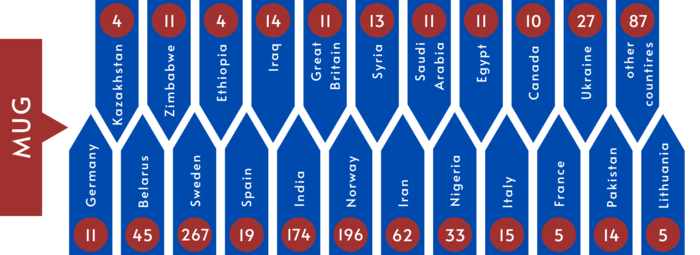The MUG is still the most internationalized university in Pomeranian
4.01.2023

Foreign students studying in Gdańsk most often choose the Medical University of Gdańsk. The trend that has been maintained for years is confirmed by the latest report Foreign students in Poland 2022 prepared as part of the Study in Poland program implemented by the Conference of Rectors of Academic Schools in Poland and the Perspektywy Educational Foundation.
The position of the MUG compared to other universities in Poland
There are 3,748 foreign students studying in the Pomeranian Voivodeship (including 3,119 at public universities). Out of 2,871 students from other countries studying in Gdańsk, as many as 1,050 (36.6%) chose the MUG, which thus remains 1st among the most popular Gdańsk universities among foreigners. The total number of full-time students studying at the MUG is 6,344 (including 1,050 foreign students).
Among the leading Polish universities in terms of the number of foreign students, the Medical University of Gdańsk is 21st with the number of 1,050 students (increase by 3%). In terms of the number of people in the field of medicine, the University is 2nd, in the field of nursing 8th. Most foreign students of the MUG come from Sweden (267 people), Norway (196 people) and India (174 people).
Activities in the field of internationalization are carried out at the MUG by the Internationalization Office. His most important tasks include: organization of international cooperation, support for foreign students and building relations with foreign graduates of the University. The Head of the Office Ewa Kiszka talks about the importance of such initiatives.

We are very happy to maintain the status of the most internationalized university in Pomerania and one of the most internationalized in Poland. Thanks to the huge work of the Recruitment Department under the leadership of Dr. Habil. Sławomir Wójcik, fruitful cooperation of many other MUG units, as well as its surroundings, currently we have over 1,000 students from nearly 70 countries around the world, which is 16.5% of the total with the national average of 7.34%. This cultural diversity requires us to take actions that support and integrate our community. These activities are carried out by the Internationalization Office, which includes the Department of International Relations, the Welcome Point and the International Alumni Relations Officer.
Our University puts special emphasis on increasing the level of internationalization and strengthening the image and recognition in the world. All activities related to international cooperation and foreign mobility are supported. It is extremely important to develop fields of study open to candidates from around the world, as well as to improve the language and cultural competences of the academic community, and to reorganize and adapt the university administration to support scientists. These are activities at the strategic and operational level, direct and indirect, partnership and support, adapted to changing needs.
A university with a high level of internationalization, open to the world, is one that gives members of its community the opportunity to gain international experience, not only through individual mobility, but also through the opportunity to study and work in an international environment, without the need to move. For such a university, the personal development of employees and students, improving competences, care for the quality of research and the teaching process, and creating a climate conducive to development in the international dimension is one of the main goals of development.

The internationalization rate of Polish universities is 7.34%, and the one of the MUG is 16.5%.
In the academic year 2021/2022, nearly 90,000 foreign students from 180 countries studied in Poland (an increase of 5.6%). There was also an increase in the internationalization rate to 7.34%. The dominant group so far are students from Belarus and Ukraine. The third largest group are Turks, followed by Indians. There is an increasing interest in studying in Poland on the part of candidates from Asia (Kazakhstan, Uzbekistan, Azerbaijan), while the number of candidates from Africa (Ethiopia, Rwanda, Zimbabwe) is increasing. Medical studies are most often chosen by students from Sweden, Norway and the United States. New this year were entries from Bermuda, Northern Mariana Islands and Curacao.
In the world, over 6.4 million people study abroad. Countries such as the United States, Great Britain, Australia and France enjoy the greatest interest. There are still fewer foreign students studying in Poland than in our neighbours (Czech Republic, Hungary, Slovakia, Lithuania) or in other developed OECD countries.
graphics by Magda Boguska/MUG